Related Research Articles

Andronicus of Cyrrhus or Andronicus Cyrrhestes was a Hellenized Macedonian astronomer best known for designing the Tower of the Winds in Roman Athens.
Cocytus or Kokytos is the river of wailing in the underworld in Greek mythology. Cocytus flows into the river Acheron, on the other side of which lies Hades, the underworld, the mythological abode of the dead. There are five rivers encircling Hades: the Styx, Phlegethon, Lethe, Acheron and Cocytus.

The River Tees, in England, rises on the eastern slope of Cross Fell in the North Pennines and flows eastwards for 85 miles (137 km) to reach the North Sea in the North East of England. The modern day history of the river has been tied with the industries on Teesside in its lower reaches, where it has provided the means of import and export of goods to and from the North East England. The need for water further downstream also meant that reservoirs were built in the extreme upper reaches, such as Cow Green.
In the study of Earth's atmosphere, polar easterlies are the dry, cold prevailing winds that blow around the high-pressure areas of the polar highs at the North and South Poles. Cold air subsides at the poles creating high pressure zones, forcing an equatorward outflow of air; that outflow is then deflected westward by the Coriolis effect. Unlike the westerlies in the middle latitudes and trade winds in tropics, the polar easterlies are often weak and irregular. Note, winds are named based on where they came from. The polar easterlies are one of the five primary wind zones, known as wind belts, that make up our atmosphere's circulatory system. This particular belt of wind begins at approximately 60 degrees north and south latitude and reaches to the poles.
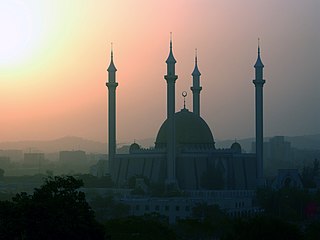
The Harmattan is a season in West Africa that occurs between the end of November and the middle of March. It is characterized by the dry and dusty northeasterly trade wind, of the same name, which blows from the Sahara over West Africa into the Gulf of Guinea. The name is related to the word haramata in the Twi language. The temperature is cold mostly at night in some places but can be very hot in certain places during daytime. generally, temperature differences can also depend on local circumstances.
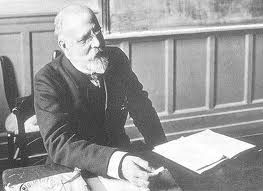
Charles Simon Clermont-Ganneau was a noted French Orientalist and archaeologist.

A tropical wave, in and around the Atlantic Ocean, is a type of atmospheric trough, an elongated area of relatively low air pressure, oriented north to south, which moves from east to west across the tropics, causing areas of cloudiness and thunderstorms. Tropical waves form in the easterly flow along the equatorial side of the subtropical ridge or belt of high air pressure which lies north and south of the Intertropical Convergence Zone (ITCZ). Tropical waves are generally carried westward by the prevailing easterly winds along the tropics and subtropics near the equator. They can lead to the formation of tropical cyclones in the north Atlantic and northeastern Pacific basins. A tropical wave study is aided by Hovmöller diagrams, a graph of meteorological data.

Toamasina, meaning "like salt" or "salty", unofficially and in French Tamatave, is the capital of the Atsinanana region on the east coast of Madagascar on the Indian Ocean. The city is the chief seaport of the country, situated 215 km (134 mi) northeast of its capital and biggest city Antananarivo. In 2018 Toamasina had a population of 325,857.

Teck Castle was a ducal castle in the kingdom of Württemberg, immediately to the north of the Swabian Jura and south of the town of Kirchheim unter Teck. The castle took its name from the Teckberg ridge, 2,544 feet (775 m) high, which it crowned. It was destroyed in the German Peasants' War (1525). The site's current buildings were constructed during the 19th and 20th centuries on the ruins of the original castle.

The Brickfielder is a hot and dry wind in Southern Australia that develops in the country's deserts in late spring and summer, which heavily raises temperatures in the southeast coast.
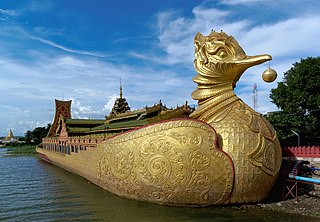
Meiktila is a city in central Burma on the banks of Meiktila Lake in the Mandalay Region at the junctions of the Bagan-Taunggyi, Yangon-Mandalay and Meiktila-Myingyan highways. Because of its strategic position, Meiktila is home to Myanmar Air Force's central command and Meiktila Air Force Base. The country's main aerospace engineering university, Myanmar Aerospace Engineering University is also located in Meiktila. As of 2021, the city had a population of 177,442.

Clermont-l'Hérault is a commune in the Hérault department in southern France.

In architecture, wind braces are diagonal braces to tie the rafters of a roof together and prevent racking. In medieval roofs they are arched, and run from the principal rafters to catch the purlins.
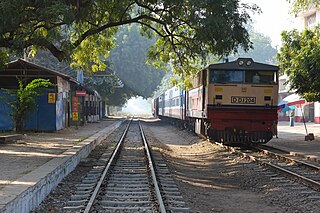
Myingyan is a city and district in the Mandalay Division of central Myanmar, previously, it was a district in the Meiktila Division of Upper Burma. It is currently the capital of Myingyan Township and lies along the National Highway 2. As of 2014, the city had a population of 276,096 and the district had 1,055,957.
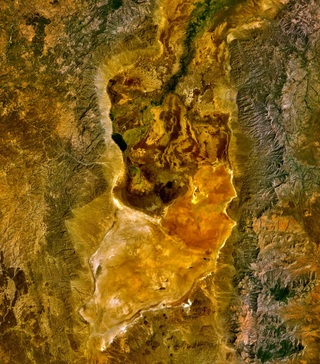
Lake Chew Bahir or Lake Istifanos, also called Stefanie, Basso Naebor and Chuwaha, is a lake in southern Ethiopia, located on the southwestern end of the Southern Nations, Nationalities and Peoples' Region, near the border with Oromia Region.
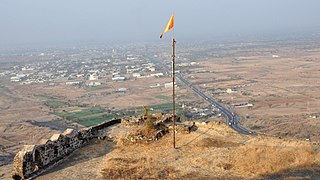
Dhule district is a district of Maharashtra, India. The city of Dhule is the administrative headquarters of the district. It is part of North Maharashtra.

A muff is a fashion accessory for outdoors usually made of a cylinder of fur or fabric with both ends open for keeping the hands warm. It was introduced to women's fashion in the 16th century and was popular with both men and women in the 17th and 18th centuries. By the early 19th century, muffs were used in Europe only by women. It is also reported that the fashion largely fell out of style in the 19th century.
The Lines of Weissenburg, or Lines of Wissembourg, were entrenched works — an earthen rampart dotted with small outworks — along the river Lauter. They were built in 1706 and lasted into the 19th century.
References
- This article incorporates text from a publication now in the public domain : Chisholm, Hugh, ed. (1911). "Leste". Encyclopædia Britannica . Vol. 16 (11th ed.). Cambridge University Press. p. 499.